In this time of social and activity restrictions, I was initially challenged to write about easily located plants in flower…and was quite amazed at what I found.
I started off in my own garden. Outside our bedroom is a large female Drooping She-oak, Allocasuarina verticillata. I had to look for the small globular buds which I anticipated would be appearing along the branches on short stems, and there they were. They will soon open into modest orange-red flowers.
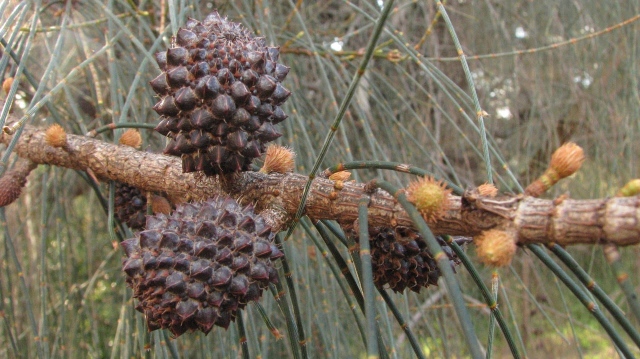 Drooping Sheoak (female)
Drooping Sheoak (female)
The much showier male plants, with their long drooping orange tassels, are found along coastal cliff tops. As I drive along the road beside the coastal reserves their soft colours look especially beautiful on sunny autumn days.
 Drooping Sheoak (male)
Drooping Sheoak (male)
On the ground in my garden I found numerous small yellow fruits on Ruby Saltbush, Enchylaena tomentosa var. tomentosa. This prostrate ground cover, which likes dry rocky sites, is doing really well as it self-seeds everywhere.
 Ruby Saltbush
Ruby Saltbush
I also found shrubs of Hop Goodenia, Goodenia ovata, covered in appealing yellow flowers with five unevenly spaced petals, separated into two and three.
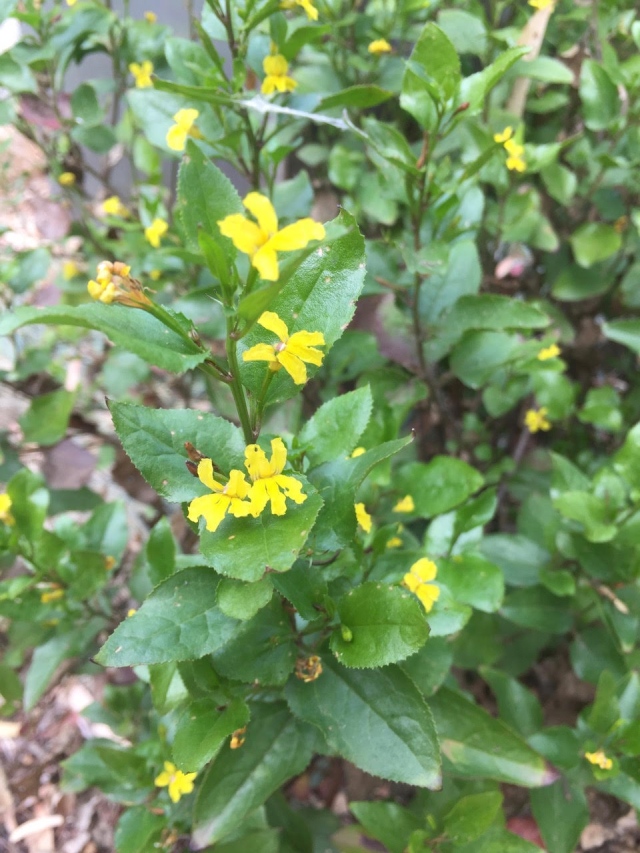 Hop Goodenia
Hop Goodenia
One more home plant was my fairly new seedlings of Common Correa, Correa reflexa, with some delightful red tubular flowers.
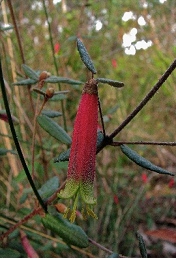 Common Correa
Common Correa
However, it was elsewhere I found the surprises. Outside the front door of the Angair office I found a lovely specimen of the Common Correa. Driving into Anglesea for my weekly shopping was my epiphany! Firstly the roundabout, with a carpet of yellow flowers, which was not a weed daisy but Common Everlasting, Chrysocephalum apiculatum. What was this spring/summer plant doing flowering again with its clusters of terminal flower heads?
 Common Everlasting
Common Everlasting
I later found them in flower at the Allen Noble Sanctuary.
Also, out of season at the sanctuary were the really gorgeous big yellow flower-heads and new drooping buds of Showy Podolepis, Podolepis jaceoides.
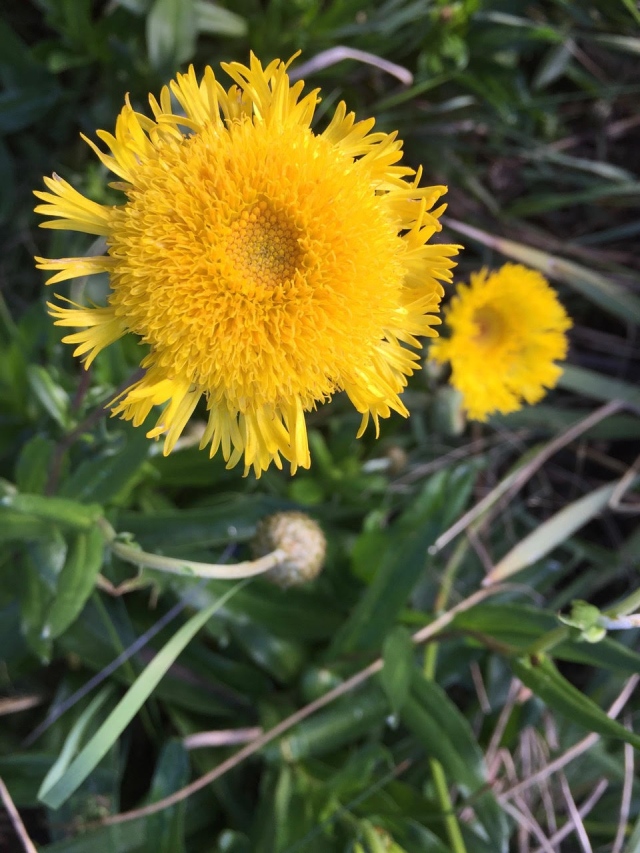 Showy Podolepsis
Showy Podolepsis
When parking opposite the Anglesea shops outside the bowling club, I literally fell over massed plantings of Small-fruit Fan-flowers, Scaevola albida, which were covered in white and pale blue fan-shaped flowers.
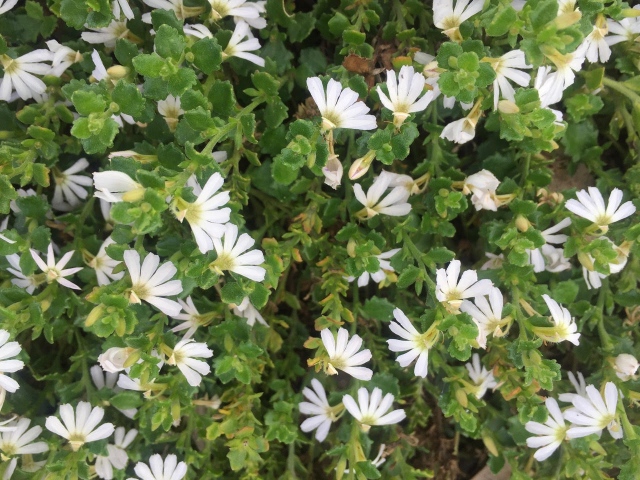 Small-fruit Fan-flowers
Small-fruit Fan-flowers
Then in the newly planted ‘horse’ reserve were several types of plants in flower including the Hop Goodenia I have in my garden.
Further afield along the Anglesea River towards the ocean, in marshy areas near the caravan park, I found some lovely remaining examples of white Grass Daisy, Brachyscome graminea.
 Grass Daisy
Grass Daisy
We are all familiar with its similar cousin, Cut-leaf Daisy, B. multifida, but this plant is less known due to its restricted habitat of swampy wetlands.
Later I was ‘lured’ further afield due to three reports of one of my favourite flowers, which I have not seen for several years, Twining Glycine, Glycine clandestina. I always look for, but fail to find this for the Angair show, so next spring I will look much later in the year. I was most excited to find it beside the Anglesea River near Coogoorah Park, twining high up in the bushes with its small, dainty, mauve pea-flowers and long narrow leaves in threes. Unfortunately, the flowers were nearly finished, were too small for my camera to focus, and then the rampageous Anglesea mosquitos drove me away. Fortunately, our editor (DW) had taken a nice photo to reproduce here.
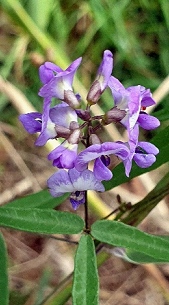 Twining Glycine
Twining Glycine
Finally, when walking beside the road, on the grassy verge outside the Aireys Inlet Hotel, I saw several matted plants of Cranberry Heath, Astroloma humifusum, bravely growing amongst the introduced grasses and weeds. How have these plants, with their almost hidden rich red tubular flowers, survived in this totally hostile environment?
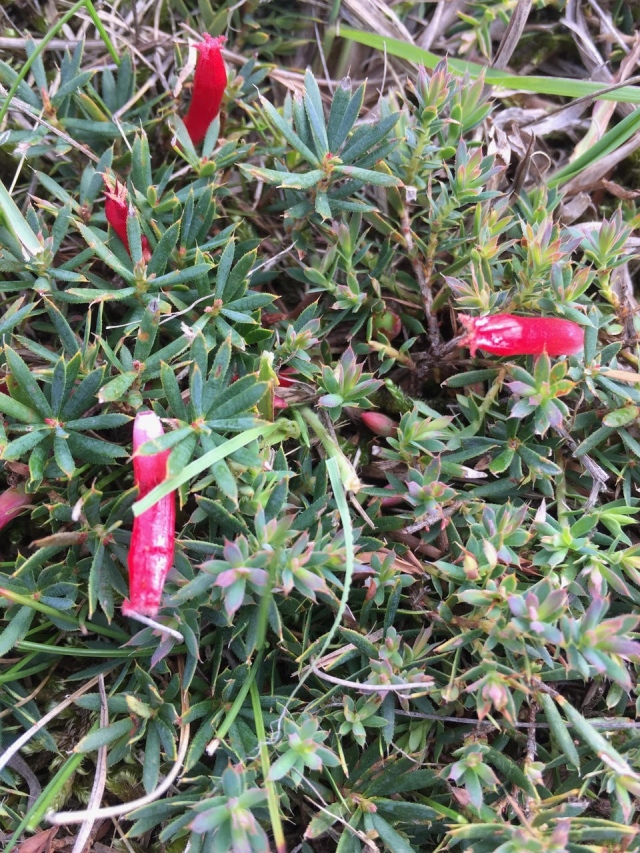 Cranberry Heath
Cranberry Heath
Just before writing this I was told of a delightful, tiny, four-petalled, pale (spring) flower growing in Fraser Avenue. If it is still in flower, I will write about it next month, but maybe you will find it before then with the help of your Flowers of Anglesea and Aireys Inlet … best of luck!
STAYING HOME…
There it is again … the movement. I put my head down and read a bit more, but no … it’s not well. A sugar ant with four and a half legs, determined to get across the tiled patio in front of my chair. But where is the usual racing line of its community running across at full speed ahead? Just this one poor ant ploughing on taking the ‘safe’ route along the edge, but then having to negotiate leaves, stones sticks and other garden debris. Life is different, the usual things don’t happen … safety is the priority, but what to do next, where to go when all the usual things are not safe? I read a few more pages … it is still ploughing on. I follow its journey till it finally reaches the other side and disappears into the safety of the foliage in the garden. What will I do next when I finish the book … brave the streets, bush or beach for much needed exercise but avoiding all human contact, read another book, do a jigsaw, tackle some of those jobs I have always put off? Usual life is in limbo for who knows how long … all normal activities cancelled, access to grandchildren forbidden, weather getting colder. I guess the answer is to ‘soldier on’ like the ant. The priority is to stay well until normal life resumes for us … but not the ant. Keep safe.
Ellinor Campbell